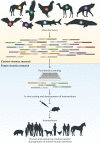Bat-borne virus diversity, spillover and emergence
- PMID: 32528128
- PMCID: PMC7289071
- DOI: 10.1038/s41579-020-0394-z
Bat-borne virus diversity, spillover and emergence
Abstract
Most viral pathogens in humans have animal origins and arose through cross-species transmission. Over the past 50 years, several viruses, including Ebola virus, Marburg virus, Nipah virus, Hendra virus, severe acute respiratory syndrome coronavirus (SARS-CoV), Middle East respiratory coronavirus (MERS-CoV) and SARS-CoV-2, have been linked back to various bat species. Despite decades of research into bats and the pathogens they carry, the fields of bat virus ecology and molecular biology are still nascent, with many questions largely unexplored, thus hindering our ability to anticipate and prepare for the next viral outbreak. In this Review, we discuss the latest advancements and understanding of bat-borne viruses, reflecting on current knowledge gaps and outlining the potential routes for future research as well as for outbreak response and prevention efforts.
Conflict of interest statement
The authors declare no competing interests.
Figures



Similar articles
-
Viruses in bats and potential spillover to animals and humans.Curr Opin Virol. 2019 Feb;34:79-89. doi: 10.1016/j.coviro.2018.12.007. Epub 2019 Jan 18. Curr Opin Virol. 2019. PMID: 30665189 Free PMC article. Review.
-
[Bats and Viruses: complex relationships].Bull Soc Pathol Exot. 2015 Oct;108(4):272-89. doi: 10.1007/s13149-015-0448-z. Epub 2015 Sep 1. Bull Soc Pathol Exot. 2015. PMID: 26330152 Free PMC article. Review.
-
Bats as reservoirs of severe emerging infectious diseases.Virus Res. 2015 Jul 2;205:1-6. doi: 10.1016/j.virusres.2015.05.006. Epub 2015 May 18. Virus Res. 2015. PMID: 25997928 Free PMC article. Review.
-
A tale of endurance: bats, viruses and immune dynamics.Future Microbiol. 2024 Jun 12;19(9):841-856. doi: 10.2217/fmb-2023-0233. Epub 2024 Apr 22. Future Microbiol. 2024. PMID: 38648093 Review.
-
Emerging viruses: coming in on a wrinkled wing and a prayer.Clin Infect Dis. 2007 Mar 1;44(5):711-7. doi: 10.1086/511078. Epub 2007 Jan 23. Clin Infect Dis. 2007. PMID: 17278066 Free PMC article. Review.
Cited by
-
Full-genome sequencing of dozens of new DNA viruses found in Spanish bat feces.Microbiol Spectr. 2024 Aug 6;12(8):e0067524. doi: 10.1128/spectrum.00675-24. Epub 2024 Jul 11. Microbiol Spectr. 2024. PMID: 38990026 Free PMC article.
-
Computational Viromics: Applications of the Computational Biology in Viromics Studies.Virol Sin. 2021 Oct;36(5):1256-1260. doi: 10.1007/s12250-021-00395-7. Epub 2021 May 31. Virol Sin. 2021. PMID: 34057678 Free PMC article. No abstract available.
-
Proteomics in Non-model Organisms: A New Analytical Frontier.J Proteome Res. 2020 Sep 4;19(9):3595-3606. doi: 10.1021/acs.jproteome.0c00448. Epub 2020 Aug 20. J Proteome Res. 2020. PMID: 32786681 Free PMC article.
-
Prevalence of Flavivirus and A lphavirus in bats captured in the state of Yucatan, southeastern Mexico.One Health. 2024 Aug 15;19:100876. doi: 10.1016/j.onehlt.2024.100876. eCollection 2024 Dec. One Health. 2024. PMID: 39258264 Free PMC article.
-
Evidence linking APOBEC3B genesis and evolution of innate immune antagonism by gamma-herpesvirus ribonucleotide reductases.Elife. 2022 Dec 2;11:e83893. doi: 10.7554/eLife.83893. Elife. 2022. PMID: 36458685 Free PMC article.
References
-
- Burgin CJ, Colella JP, Kahn PL, Upham NS. How many species of mammals are there? J. Mammalogy. 2018;99:1–14. doi: 10.1093/jmammal/gyx147. - DOI
Publication types
MeSH terms
Grants and funding
LinkOut - more resources
Full Text Sources
Medical
Miscellaneous

